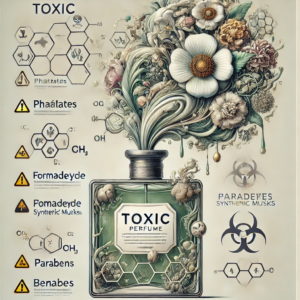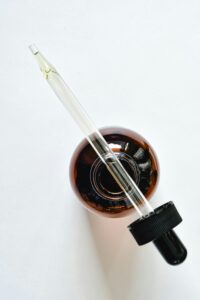
10 Toxic Perfume Ingredients
That Could Be Harming Your Health
Perfume might feel luxurious and personal, but behind that signature scent could be a mix of hidden chemicals linked to hormone imbalances, skin allergies, respiratory issues, and even cancer. Here’s a breakdown of 10 perfume ingredients that experts say are better left out of your beauty routine.
Phthalates: The Hormone Hackers
Why it’s used: To make fragrance last longer and cling to the skin.
Why they’re harmful: Phthalates are endocrine disruptors that can interfere with hormones like estrogen and testosterone, potentially leading to reproductive issues, early puberty, and developmental concerns. Found in urine, blood, and breast milk.
Styrene: A Scented Cancer Risk?
Why it’s used: It strengthens the scent’s longevity.
Why they’re harmful: Classified as a probable human carcinogen. Associated with fatigue, memory problems, and nervous system effects when inhaled repeatedly.
Synthetic Musks (e.g. Musk Ketone): The Bioaccumulators
Why it’s used: To provide a deep, musky base and fix the scent in place.
Why they’re harmful: Persist in the environment and accumulate in the body. Can mimic hormones and potentially cause fertility and thyroid issues.
Benzaldehyde: Sweet, But Not So Innocent
Why it’s used: For an almond or cherry-like scent.
Why they’re harmful: Respiratory and nervous system irritant; can cause headaches, fatigue, and throat discomfort with frequent exposure.
Benzyl Acetate: A Floral Fixative with Risks
Why it’s used: To create a fruity-floral scent, especially in jasmine blends.
Why they’re harmful: Possible carcinogen based on animal studies. Known to irritate the eyes, skin, and lungs.
Camphor: The Cooling Chemical That Can Go Too Far
Why it’s used: Adds a minty, sharp top note.
Why they’re harmful: Toxic at high levels. Can cause seizures, nausea, or confusion. Strong irritant for skin and airways.
BHT (Butylated Hydroxytoluene): The Shelf-Life Stabilizer
Why it’s used: Preserves fragrance formulas and prevents oxidation.
Why they’re harmful: Hormone disruptor; linked to fertility problems and liver effects in studies. Can also irritate the skin.
Limonene: Nature’s Citrus, with a Twist
Why it’s used: For a refreshing lemon-orange scent.
Why they’re harmful: Oxidizes in air, forming allergens. Can irritate lungs, skin, and may have toxic effects in high doses.
Linalool: Soothing Floral, Surprising Side Effects
Why it’s used: Provides a lavender-like soft scent.
Why they’re harmful: Common allergen. Can trigger skin reactions and affect the nervous system with frequent use.
Methylene Chloride: Banned but Not Forgotten
Why it’s used: As a solvent to mix and dissolve fragrance oils.
Why they’re harmful: Banned in perfumes but may still appear. Probable carcinogen; toxic to organs and converts to carbon monoxide in the body.

